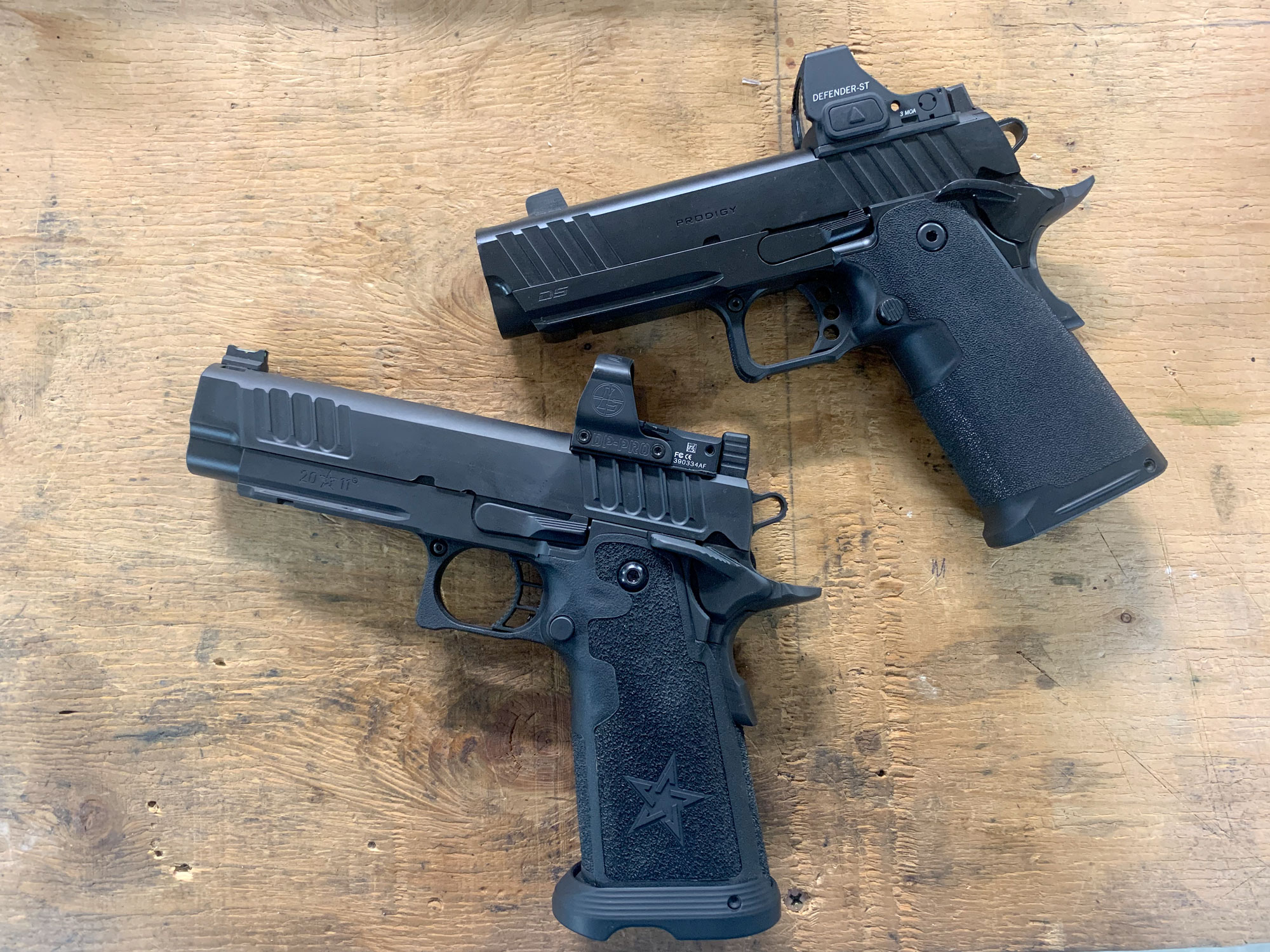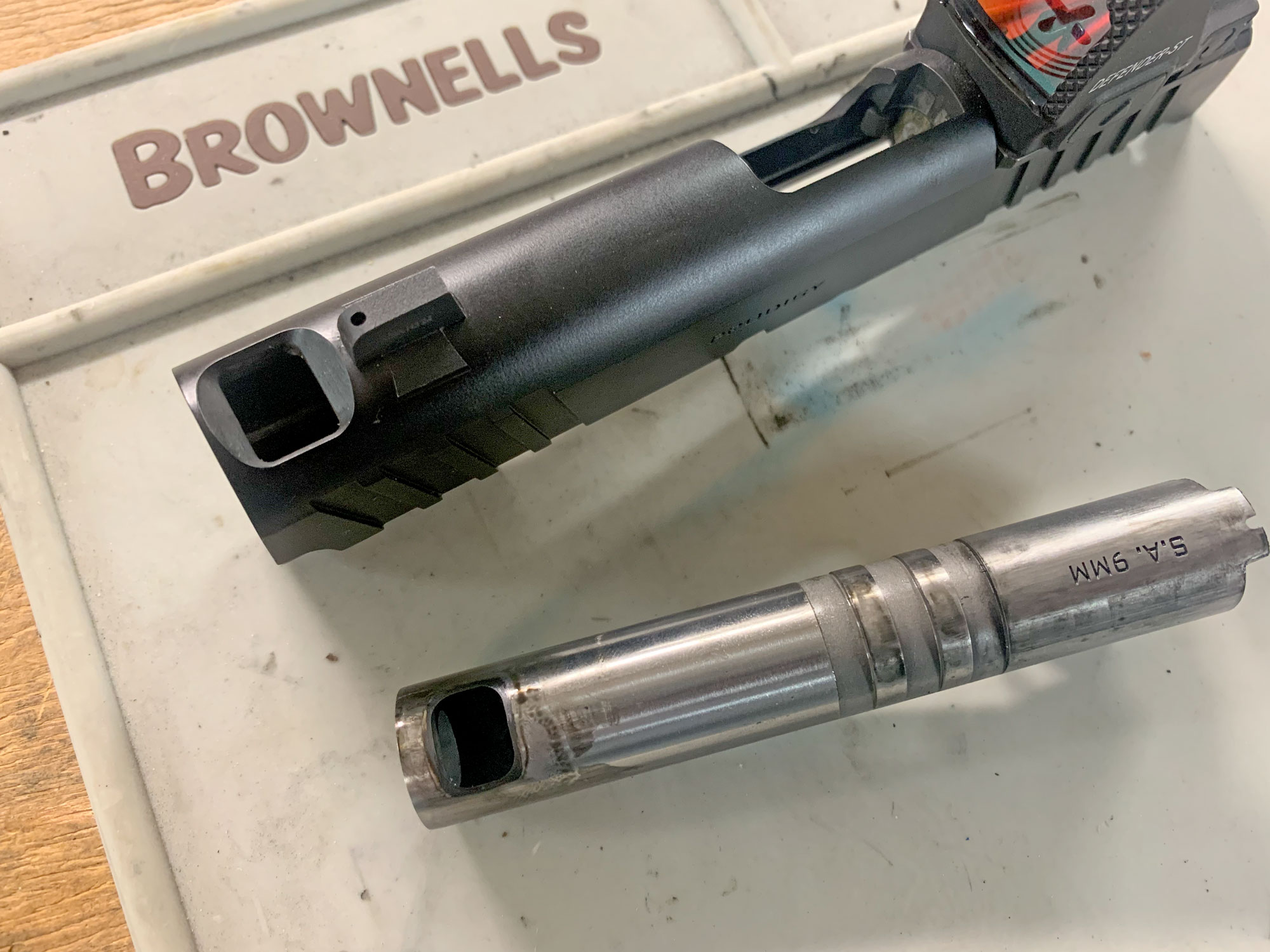We may earn revenue from the products available on this page and participate in affiliate programs. Learn More ›
The new Springfield DS Prodigy Comp is the latest in the line of double-stack 1911 9mm pistols that has really shaken up the 2011-style pistol market. The DS Prodigy was one of the first mainstream double-stack 9mms that brought a quality 2011-style pistol to the sub-$2,000 price range. We shot the hell out of them back in 2023, and I was excited to get my hands on this compensated model. The Springfield DS Prodigy Comp embraces the value and performance of the original prodigy, but presents us with an even flatter-shooting competition gun.
Springfield 1911 DS Prodigy Comp 4.25-inch Specs
- Caliber: 9mm
- Capacity: 17+1 or 20+1
- Action: Single-action, hammer-fired
- Barrel: 4.25-inch, bull profile, stainless steel, integrated compensator
- Dimensions: 7.8 inches (L) x 5.75 inches (H) x 1.28 inches (W)
- Weight: 38 ounces (with empty 17-round magazine and Vortex Defender ST red dot) (weighed)
- Frame: Carbon steel, forged
- Slide: Carbon steel, forged
- Optics: Cut for optic, uses Agency Arms adapter plates
- Controls: Right-handed slide stop, mag catch, ambidextrous safety levers
- Finish: Black Cerakote
- Grip: Polymer grip module, fine stipple texture
- Sights: Tall, fiber-optic front, serrated black “U-notch” rear (drift adjustable
- Trigger: Aluminum, single-action, curved shoe, 5 pounds, 5 ounces (measured)
- Price: $1,734
Key Features
- Integral compensator made by removing material from the barrel itself
- Agency Optic System optic plates for different red dot sights
- Tall, co-witnessing iron sights
- Includes a 17- and 20-round magazine — compatible with 2011 magazines
- Accuracy: .907 inches (average of four 5-shot groups from 15 yards)
Review Highlights
- Smooth and reliable
- Compensator works well to reduce muzzle flip
- Thumb safety fit is tighter with less play than early 1911 DS Prodigy
- Good value for a 2011-style pistol
- Great accuracy
Springfield 1911 DS Prodigy Comp Breakdown
In late 2022, the Springfield Prodigy made waves as the first mainstream 2011-style pistol in the $1,500 price range. It’s a double-stack 1911 chambered in 9mm that has a forged frame and slide, and the short frame grip module that’s characteristic of this style of pistol. The term “2011” is trademarked by Staccato, formerly STI, and the Prodigy was and is a more affordable, entry-level alternative to pistols like the Staccato P and new Staccato C.
Early production Prodigy pistols had some feeding issues, but by the time we got our samples, those were history. We’ve seen nothing but reliable performance from the Prodigy over several thousand rounds through two different pistols. You can read the full review on the original 4.25-inch Springfield 1911 DS Prodigy here, but our takeaway is that it’s a reliable, smooth-shooting pistol that brings a lot of value for its $1,300 price tag.
Other competitors have flocked to the field, and we’ve seen a couple different Turkish imports present great values as well. The modestly-priced MAC 9 DS 1911 is another good entry-level performer for 2011-style pistols, but is less refined than the Prodigy.

Front and Center: The New Compensator
The most prominent update to the Springfield 1911 DS Prodigy Comp is the integral compensator. A similar compensator was first introduced on the Hellcat Pro Comp. At first glance, this comp looks much like others which use a barrel that terminates short of the end of the slide and where the slide itself is ported and sometimes has a built-in blast chamber to redirect gasses. On 9mm pistols, many of these compensators are ornamental and don’t really drive the muzzle down much (if at all) during shooting.
The slide on the 1911 DS Prodigy Comp is ported, but the compensator’s blast chamber is literally milled out of the bull-profile barrel. The rifled portion of the barrel terminates about half an inch behind the muzzle, and this hogged-out gas chamber effectively routes gasses upward.
I fired about 500 rounds through this pistol and the addition of the compensator makes a significant difference in muzzle flip and how easily it is to keep the red dot in the field of view and on target during rapid shooting. I noted that the difference is even more pronounced in smaller pistols like the Hellcat that are more prone to muzzle flip. It’s not really fair to compare it to the dead-nuts performance of higher-end compensated guns like the Staccato XC, but it’s a really meaningful addition to the Prodigy. For a relatively small increase in price, this makes it an even more effective and attainable entry-level competition gun.

Other Significant Features of the Springfield 1911 DS Prodigy Comp
There aren’t a lot of changes that we see from non-comp Prodigy models, but one is the use of taller iron sights that can be co-witnessed through a wide variety of red dot optics. Also, it’s notable that the front sight has been relocated back behind the muzzle compensator. This should help a bit with sight picture, but will also prevent the tritium front sight bead from becoming caked with carbon fouling.
These pistols, like earlier Prodigies, use the Agency Optic Systems mounting plates to accommodate different footprints. The one I tested wore a Vortex Defender-ST red dot sight, a nice optic with a wide viewing window that made running my Birchwood Casey plate rack a breeze.
This pistol has a comfortable grip module that features a fine stipple texture that’s grippy but not too aggressive. Controls are the same as you’ll see on other Prodigy pistols, but I did notice that the ambidextrous thumb safeties seem better fit than those on the original Prodigy I tested. These operate crisply and when in the “fire” position, there is almost no squishiness or play in the safety levers — something that the original Prodigy had.

The Prodigy has a trigger that, by striker-fired standards, is good, but it’s a bit stiff for a competition double-stack 9mm. Fortunately, it’s compatible with some aftermarket mods and options to improve it if you desire.
Also like other models, the Springfield 1911 DS Prodigy Comp comes with two magazines: one 17-round and one 20-rounder, made by Duramag. The pistol is also compatible with the Staccato brand and other 2011-style bottleneck magazines, but I didn’t experience any malfunctions or issues using what came with the gun.
Springfield 1911 DS Prodigy Comp Shooting Performance
No news is good news when it comes to pistol reliability, and we’ve come to expect modern handguns to be just that. I tested this Prodigy (and others) with all common-weight bullets and different types of practice and defensive ammo. Everything from 115-grain steel-cased FMJ through 147-grain JHP and 100-grain Black Hills Honey Badger monolithics functioned without incident.
For accuracy testing, I followed our handgun protocol of averaging five-shot group sizes fired from 15 yards from a standing position, using a bagged tripod for support. The Springfield 1911 DS Prodigy Comp was surprisingly accurate, averaging .907 inch groups using Staccato match ammunition. For reference, most of the handguns we test average between 1.5- and 2-inch group sizes at 15 yards. Under an inch is exceptional. When running through steel arrays, I could precisely hit 8- to 12-inch steel targets at 50 yards, and accuracy is certainly sufficient for A-zone hits at any practical distance.

Final Thoughts on the Springfield 1911 DS Prodigy Comp
We are always excited to see companies add meaningful updates to their product lines — especially when they’re accomplishing what they set out to do. This pistol integrates a compensator that does successfully improve shooting performance, and does it at a pretty minimal price increase. They’re just hitting the market, but I’d suspect that street price will settle at a hundred or two hundred bucks more than the standard Prodigy. For shooters interested in competing with a 2011-style gun (or just recreational shooting), this is an excellent option.
